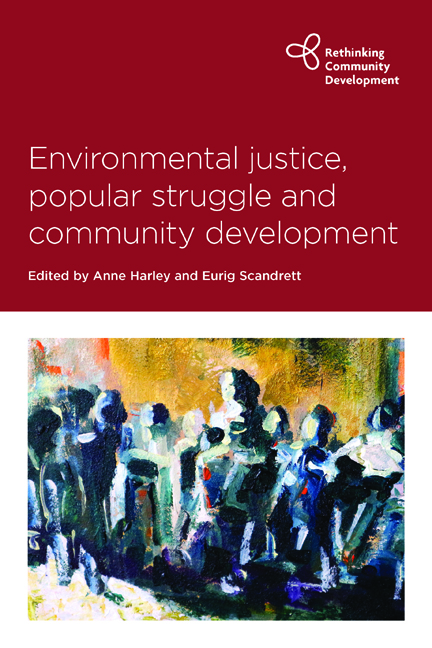Book contents
- Frontmatter
- Dedication
- Contents
- List of figures
- Series editors’ preface: Rethinking Community Development
- Preface
- Acknowledgements
- Notes on contributors
- Abbreviations
- One Community, development and popular struggles for environmental justice
- Two Resisting Shell in Ireland: making and remaking alliances between communities, movements and activists
- Three ‘No tenemos armas pero tenemos dignidad’: learning from the civic strike in Buenaventura, Colombia
- Four No pollution and no Roma in my backyard: class and race in framing local activism in Laborov, eastern Slovakia
- Five Tackling waste in Scotland: incineration, business and politics vs community activism
- Six An unfractured line: an academic tale of self-reflective social movement learning in the Nova Scotia anti-fracking movement
- Seven ‘Mines come to bring poverty’: extractive industry in the life of the people in KwaZulu-Natal, South Africa
- Eight Ecological justice for Palestine
- Nine Learning and teaching: reflections on an environmental justice school for activists in South Africa
- Ten The environment as a site of struggle against settler-colonisation in Palestine
- Eleven Communities resisting environmental injustice in India: philanthrocapitalism and incorporation of people’s movements
- Twelve Grassroots struggles to protect occupational and environmental health
- Conclusion
- Index
Eight - Ecological justice for Palestine
Published online by Cambridge University Press: 27 April 2022
- Frontmatter
- Dedication
- Contents
- List of figures
- Series editors’ preface: Rethinking Community Development
- Preface
- Acknowledgements
- Notes on contributors
- Abbreviations
- One Community, development and popular struggles for environmental justice
- Two Resisting Shell in Ireland: making and remaking alliances between communities, movements and activists
- Three ‘No tenemos armas pero tenemos dignidad’: learning from the civic strike in Buenaventura, Colombia
- Four No pollution and no Roma in my backyard: class and race in framing local activism in Laborov, eastern Slovakia
- Five Tackling waste in Scotland: incineration, business and politics vs community activism
- Six An unfractured line: an academic tale of self-reflective social movement learning in the Nova Scotia anti-fracking movement
- Seven ‘Mines come to bring poverty’: extractive industry in the life of the people in KwaZulu-Natal, South Africa
- Eight Ecological justice for Palestine
- Nine Learning and teaching: reflections on an environmental justice school for activists in South Africa
- Ten The environment as a site of struggle against settler-colonisation in Palestine
- Eleven Communities resisting environmental injustice in India: philanthrocapitalism and incorporation of people’s movements
- Twelve Grassroots struggles to protect occupational and environmental health
- Conclusion
- Index
Summary
Introduction
Palestine, throughout history, was the cradle of several civilisations, religions and cultures. It enjoys a privileged geographical location at the junction of three continents: Asia, Europe and Africa. Compared to other countries Palestine is a small area, yet its environment contains a wide range of temperatures, rainfall and topography. The Bible includes the earliest written descriptions of the diversity existing in historic Palestine. Its ecology and biodiversity make Palestine a natural museum.
The native people of Palestine, namely the Canaanites, also date back to early historical times, growing and changing with their natural environment. They have lived continuously in this land, developing a strong relationship and identity with the land, creating their own exclusive natural and cultural heritage. Unfortunately, the vibrancy of Palestine and its vital geographical location aroused the ambitions of invaders and rulers throughout history. It became a focal point for many colonial powers who realised its potential as a central hub for commercial routes. It also attracted religious groups because of its biblical significance. It endured intense wars to claim and reclaim prominent holy sites, as witnessed by the Crusades and the Zionist movement. The constant fight for land deprived the people of Palestine of the possibility of achieving political independence. However, their unbroken presence throughout the land gave it its identity and contributed to the evolving civilisations and provided a great gift to humanity in the Fertile Crescent, through the development of agricultural practices and domestication of animals.
The colonisation of Palestine
The most current foreign body to want Palestinian land is the Zionist movement, intent on the Jews ‘coming home’ to the land that was promised to them according to the Hebrew Bible. The Zionist movement was founded in 1897 by Theodor Herzl, who succeeded in promoting the idea of establishing a homeland for the world's Jews. Argentina and Uganda were among the proposed countries for this dream of establishing a homeland for the Jews, but Herzl encouraged Jews to migrate to Palestine. Organisations were then created to raise funds to buy land in Palestine and build colonies in order to create a fait accompli. Herzl mobilised support for the Zionist movement in other parts of the world.
- Type
- Chapter
- Information
- Publisher: Bristol University PressPrint publication year: 2019

